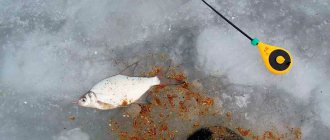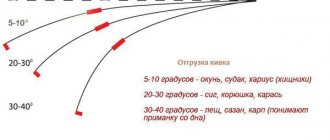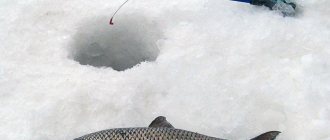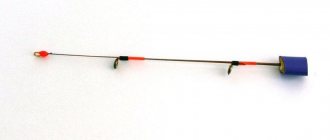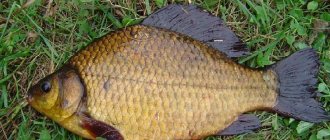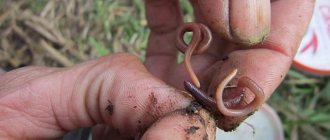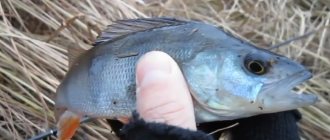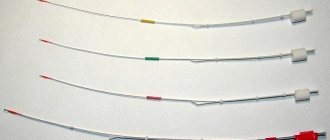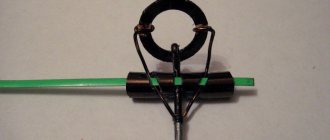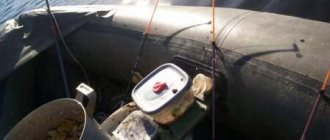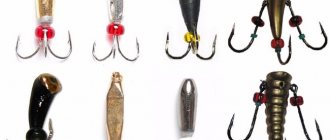The role of the nod when fishing with a reelless bait
Reelless fishing is an art. In order for fishing to be successful, you need to choose the right jig, and choose the optimal combination from the infinite number of combinations of game elements.
Game elements
- The vibration of a jig, characterized by a certain frequency and amplitude.
- Raising the jig at a certain speed with or without play.
- Lowering the jig at a certain speed with or without play.
- Pauses in wiring of varying duration and frequency.
In addition, sometimes additional elements are important:
- hitting the jig on the bottom with different strength and frequency, from 1 to 5;
- lateral movements of the jig vary in duration and speed.
It is obvious that each element of the game is infinitely variable, and in the complex the variability of each element creates an infinite number of game combinations.
Is the nod irreplaceable?
Elements of the game, except for the vibration of the jig, can be provided with any winter fishing rod.
You can create a whip of a certain flexibility, which will ensure vibrations of the jig in a wide range of frequencies and amplitudes. But the range of vibrations is limited by the flexibility and elasticity of the whip. In order to select a different range of play, you will have to replace the whip.
In sport fishing, where even a small technical advantage can ensure victory, saving on materials is not accepted. A flexible whip is much more expensive than a nod, but it is less susceptible to wind, and the bite is better in the hand. Athletes often prefer a nodule rig with a whip made of carbon, carbon fiber or vinyl.
Many jig makers still believe that it is more advisable to use inexpensive, replaceable flexible and elastic tips - nods.
The nod must fulfill a number of requirements:
- restore geometry after loading;
- maintain properties at low temperatures;
- be sensitive to cautious bites;
- be minimally exposed to wind and other natural phenomena;
- should be visible against the white background of snow.
Build
Nods can, like rods, be characterized by action.
Fast - bending 1/3 of the upper part of the nod. Characteristic of conical nods. Provide high-frequency, low-amplitude play.
Middle - bending the middle part of the nod. Characteristic of hard nods. Provide high and mid-frequency, medium and high-amplitude play.
Slow - bending the nod along the entire length. Characteristic of straight, hard nods. Provide low-frequency, high-amplitude, smooth playing.
The Importance of Beads
If you want to “revive” the game of your bait, then beads will give it the appearance of a moving bug, or any other bait. Thus, they should be moderately mobile.
It is necessary that the beads tap the hook wire during fishing, which requires a certain gap. As a result, this can cause the beads to fly off the hook; to prevent this from happening, use a silicone stopper.
Several beads work well, optimally 2-3, choose a contrasting color (white, red, yellow or green), the shape is small, with a large hole. You can safely put together these combinations.
The use of beads is an important aspect of hunting, for example, some baits without them practically do not give a bite.
it's not the same for everybody. How can you collect if you don’t understand what to collect. You know better than we are just a village. Well, it’s nonsense to write, this is everyone’s business, including yours!!
Victorych with
biuik
Steser
Blocked
Evgeniy L.
Pilyulkin
Victorych with
it's not the same for everybody. How can you collect if you don’t understand what to collect. You know better than we are just a village. Well, it’s nonsense to write, this is everyone’s business, including yours!!
———- Message added at 17:03 ———- Previous message posted at 17:02 ———-
you're just unlucky 100%
———- Message added at 17:04 ———- Previous message posted at 17:03 ———-
I answered the fisherman and this is my opinion and I will not change it. this year I wrote that I would try to collect the gear myself and now there is something to look at!! where to take an example!!
Tips for fisherman: Reelless for roach in winter are the most catchy - What is the difference, pros and cons
August
Pilyulkin
Victorych with
Pilyulkin
medic
Steser
Blocked
Andrey S
And off we go! Experienced fishermen diligently dissuade. Like, you can’t learn anything from something ready-made; obvious overpayment for a fishing rod; The Internet is full of information on how to assemble good tackle yourself. Another option is to find someone experienced (of course, this would be good, but it must be earned, so that someone experienced will fully and regularly babysit the newcomer). In general, you push a person so that he without fail rushes to fill his own cones. To take the path of trial and error.
If you try to do this yourself from scratch, you can easily break down. So, I subscribe to Viktorovich’s comments. Start with normal ready-made gear, and then, as some of its shortcomings and limitations are identified, take action and look for alternatives. After all, everything is learned by comparison.
Finally, a few thoughts on independently assembling tackle for a nozzle.
By the way, I recently watched penguin videos and noticed an interesting model of the nod - the first 3.5-4 cm are hard, and then there is a not particularly smooth transition to “snot”. The whole nod is 10 centimeters. I’ll definitely make myself one of these!
My fishing is 90% in still water, mostly at depths from 1 to 5 meters. The weight of the jig is 0.3-0.4 g. (favorite range at the moment), sometimes up to 0.7 g. Types of jigs - uralka, droplets, pellets, ants, bananas, etc., sometimes goats. I rarely catch devils, store-bought ones don’t work (although I regularly buy them for testing, but never get around to trying them), homemade ones are in my plans, but I’m lazy.
I use 0.1 -0.12 fishing line.
I forgot about the coils. For me, there is no fundamental difference yet: open, closed, semi-closed. A beginner must pay attention so that the line does not get chewed by the spool. If at the same time the design is not dismountable (the spool cannot be removed from the axis), then it is generally tin. You'll have to tear the fishing line and tie it on a new one.
Weight of the rod assembly. Personally, I’m not bothered by a 40-50 gram weight, but if a weight of no more than 40 grams is objectively desirable, but this is not a dogma.
«>
Kinds
There are a great variety of nods made from various materials and various designs. One of the typification options is to characterize nods by shape.
Straight
Straight nod - a trapezoidal hard nod with a medium or slow action. Used at shallow depths.
For proper low-frequency play, the winter fishing rod should be positioned horizontally.
Curved Down
Conical nod with fast action for working at shallow and medium depths . The tip of the nod is directed coaxially with the fishing line perpendicular to the surface of the water. To create high-frequency, low-amplitude vibrations, the fishing rod is placed at an angle of 30-60°.
Curved up
A long, rigid nod, usually made of a metal plate. About a third of the nod is smoothly curved upward. When loaded, the jig should form a straight line with the whip.
The nod is capable of averaging the amplitude of vibrations of the whip, i.e. essentially corrects the fisherman's mistakes .
Overloaded
The term guard is more suitable for such a nod (sometimes called a snot), since at great depths it is not he who is involved in the game, but the tip of the whip. Snot is used at great depths for heavy jigs and serves to signal bites (rising to the surface).
It is made from thick fishing line, twisted into a spiral, kept for 15 minutes in boiling water.
Spring
A nod of complex design, which can be called universal , since its rigidity and structure change due to the extension of plates of different lengths. Thus, you can change the frequency and amplitude of the oscillations.
Design features of a winter fishing rod
Winter fishing has a number of advantages over summer fishing. Firstly, you don’t need large gear, and secondly, it’s easier to search for fish throughout the entire reservoir.
A standard winter fishing rod consists of:
- fishing rod - handle and reel;
- whip up to 40 cm long;
- nod with bright colors;
- jigs.
For convenience, supports such as legs are attached to the fishing rod for installation on ice. For fishing with a jig, a fishing rod with a closed reel is suitable; a thinner line is used, which freezes quickly. These reels are made of plastic. The main thing when choosing such a fishing rod is the free rotation of the reel without jamming. The handle should fit comfortably in your hand. In a winter fishing rod, a fishing rod or a whip is used to set the action of the bait and to hook the fish. When fishing with a jig, the whip plays an important role.
The wiring and the result of hooking depend on its quality. This element must be optimal in rigidity and length. It is usually made from polypropylene or polystyrene. Another important element in this fishing rod is the nod (guard). It serves as a bite alarm and ensures the action of the bait. The best winter fishing gear is made by the fishermen themselves. For example, to catch perch with a jig, the nod is made from a steel spring from a watch.
What are nods for?
To choose the right nod for fishing, you need experience in their use. This element of gear in the form of a thin strip of elastic material is attached to the whip with a clamp or improvised materials. Used for catching all types of fish. A well-chosen and properly adjusted high-quality nod will make the bait play almost perfect and signal a bite.
What are nods made of?
There are plenty of materials for making nods, but they are mainly made from:
- lavsan;
- thin sheet steel;
- clock steel spring;
- wild boar wool.
Nods from the store rarely satisfy experienced anglers. In most cases, homemade ones are used. To successfully play with a jig, it is important to choose the right stiffness and length of this element. Unsuitable stiffness can turn a winter fishing rod into an unusable tackle. And a nod that is too soft will dangle in the wind.
Nods can be hard, soft, or medium. For example, hard ones are suitable for fishing in strong currents and at depth.
Gear selection
All types of nods can be classified according to their rigidity:
- soft - for fishing without current;
- medium - suitable for all waters, here the skill of the fisherman plays a big role;
- hard - for fishing in the current and at a depth of more than 5 meters.
The choice of this tackle also depends on the weight of the jig itself. For tungsten, the nod should be more rigid. When choosing the right guard for this jig at depth, one must take into account such a circumstance as water flow.
The vibration of the water flow should not be transmitted to the tackle. For such fishing you need a hard nod, for example, made of thin springy steel. It is fixed movably on a whip, and the length can be changed during the fishing process. And for catching perch, short ones made of thick fishing line are suitable.
Setting up a nod for a reelless lure (these are the main lures when fishing from ice) is not an easy task.
Reelless fishing rod:
- the fishing rod should be simple and reliable;
- the fishing rod should be light, since you have to constantly play with the jig;
- coil - large diameter (5 cm or more);
- the fishing rod handle has low thermal conductivity for ease of holding with bare hands in the cold;
- the nod approaches the fishing spot.
Material of purchased nods
Lavsan
Wear-resistant and durable, but susceptible to wind loads.
Long plastic conical nods can create low-frequency smooth amplitude oscillations (bream retrieves) with heavy reelless baits and high-frequency low-amplitude oscillations under resonance conditions.
Short conical 5-6 cm plastic nods provide high-frequency vibrations.
Single-cone nods are available for sale from 25 rubles.
Double-cone from 60 rubles.
Sportswear from 70 rubles.
X-ray film
Plastic, frost-resistant, has no memory.
Depending on the length of the nod, you can provide high-frequency play or smooth amplitude play.
The material has excessive inertia. X-ray film nods are best used when fishing at a depth of up to 2 m for catching white fish or small perch.
The cost of x-ray film nods starts from 80 rubles.
Metal
Metal nods are inert, designed for low-frequency amplitude play and quiet fishing when catching white fish.
A smooth game of swinging heavy reelless reels using long conical metal nods (15-20 cm) brings consistently good results.
Unlike plastic nods, the wind does not affect metal nods.
A beryllium bronze gatehouse costs from 70 rubles.
Combined
Spring and combined spring guards are made either from a set of plates of the same material, or from plates of different materials. In any case, combined nods allow you to change the properties of the nod and perform different games with the same nod from high-frequency to smooth low-frequency at small and large depths.
For example, the combined Mylar nod Sandvich Jig 10-30 g is suitable for both calm and aggressive wiring for moths and no-moths.
Basic selection rules
Choosing a nod for a fishing rod with a reelless rod is always a choice of purpose.
First, it would be good to decide who to catch - peaceful white fish or perch with chub. The game depends on the choice of target, and hence the choice of nod for the rewinder.
For white fish, a smooth low-frequency amplitude game with a smooth rise and fall, with periodic stops, is suitable, which means you will need a long lavsan or metal nod.
Perch requires an aggressive, high-frequency, low-amplitude game, with sharp changes in the direction of lateral movement. A short plastic nod is needed.
Additional elements of the game - tapping on the bottom, stopping and lateral movements of the jig can be beneficial.
Depending on fishing depth
The nod should provide those vibrations of the jig for which it is intended, but with increasing depth, the friction of the fishing line and the jig on the water increases, the pressure of the water column on the jig also increases, which means that vibrations are inevitably damped.
A soft conical long nod of 10-15 cm will not provide high-frequency play at a depth of more than 4 m. The length of the nod should be reduced to 6-9 cm, or a nod made of a more rigid material should be selected, i.e. As the depth of the reservoir increases, the structure of the nod should decrease and the rigidity increase.
Expert opinion
Knipovich Nikolai Mikhailovich
Zoologist, hydrobiologist. I am interested in fishing at a professional level.
Important! The nature of the game of a reelless jig largely depends on the dexterity of the fisherman’s hands. An experienced jig operator with a metal spring nod can provide any game with a reelless jig at any depth.
Shipment
Selected depending on the subject of fishing. The nod is selected or made to match the weight of the jig, or vice versa - the weight of the nozzle is selected to match the finished nod.
To check the angle of deflection, the jig is suspended from the nod on a fishing line or clings to the nod hole on the shore.
Self-production
Holder
First you need to make a nod holder. It is made from a piece of rubber by cutting a rectangular shape with a knife and drilling holes for the whip and for the nod. An additional hole is drilled to allow the fishing line to pass through.
Another way: gluing pieces of stranded wire insulation for the whip and cable insulation for the nod.
Instead of gluing, it is possible to connect pieces of insulation of different diameters in a heat-shrinkable tube.
Made from plastic materials
Lavsan, astralon, caprolavsan. Similarities and differences.
Most often, to make do-it-yourself nods, lately people have preferred to use Astralon and Caprolavsan.
They have similarities and differences with lavsan.
- Strength and wear resistance, durability.
- Small weight range for a specific plastic nod.
- Low temperature resistance.
- Instability to wind loads.
The difference is that lavsan hardens at sharply negative temperatures, while astralon and caprolavsan do not.
You can make nods from any plastic material (lavsan, astralon, caprolavsan, x-ray film, PET bottles, etc.), which can be easily cut with a knife, in the same way.
Tools:
- knife (preferably a shoemaker's knife made from a hacksaw blade for metal);
- ruler;
- awl;
- sandpaper No. 0 and No. 1.
Materials:
- plastic sheet;
- technical alcohol solution;
- nail polish.
Instructions:
- Using a sharp knife, cut out a blank of the desired shape (classic: 4 mm width at the beginning of the nod, 2 mm width at the end of the nod, length 6-8 cm).
- At the end of the workpiece, at a distance of 1 mm from the edges of the nod, a hole is made with a hot awl for the fishing line.
- The nod is cleaned with No. 0 sandpaper to remove sagging and irregularities.
- To paint a plastic nod, part of the surface is sanded with No. 1 sandpaper.
- The area to be painted is wiped with an alcohol solution.
- Part of the nod is painted with nail polish in a bright color that contrasts with the white color of the snow.
- The nod is inserted into the holder into the nod hole.
From boar bristles
Despite the disadvantages - rapid wear and fragility, there are supporters of the nod made from this natural material.
The bristles have one undeniable advantage - they are not subject to wind loads.
The nod is elastic enough to create a varied game with light reelless baits at shallow depths. Most often used for catching perch.
Making a homemade nod will not be difficult.
How to do:
- One or more braided bristles are bent at one end, forming a loop for passing fishing line, tied with regular thread and glued with waterproof glue. Sometimes, for reliability, the loop is fastened with a cambric made of heat-shrinkable tubing, which heats up and covers the base of the loop.
- The other, fluffy end is glued to prevent further unraveling and inserted into the nod holder.
From a watch spring
The clock spring in men's wristwatches has a width of 1.5 mm.
The spring is straightened by pressing it between the sharp edge of the plane and a solid flat object and then pulling it through.
Tools:
- metal scissors;
- abrasive wheel;
- caliper;
- screwdriver;
- metal drill with a diameter of 0.4 mm;
- sandpaper No. 1.
Material:
- clock spring.
Instructions:
- Measure out the required length of the workpiece and cut it with metal scissors.
- They form a symmetrical conical narrowing of the workpiece to 0.8 mm by grinding on an abrasive wheel (on a machine or on a wheel clamped in a drill). You should pay attention to symmetry. If there is a slight discrepancy between the two sides, it is better to modify the workpiece manually.
- Using a 0.4 mm metal drill, make a hole at the end of the sharp edge of the nod for passing the fishing line.
- Use sandpaper to sand the metal strip to remove burrs and irregularities.
- Place a small piece of thin stranded wire insulation (0.4 mm in diameter) into the hole under pressure to safely pull the line through.
- Form fungi on both sides of the nod by heating the insulation on a lighter flame and then pressing it with a flat object.
- To visualize the movement of the tip of the nod, you can wind several turns of red wool thread around it.
Next, you should insert the whip into the holder.
Combined with variable hardness
Tools:
- hammer;
- pliers;
- metal scissors;
- scissors;
- needle file
Materials:
- a piece of insulating material (preferably PVC) of stranded wire with a diameter of 6-8 mm;
- iron student ruler 0.1-0.15 mm thick;
- ferrous wire 0.4 mm.
Instructions:
- A through hole is made at the end of the PVC tube, and a tube is inserted into the hole to pass the fishing line. A small diameter tube made of wire insulating material forms fungi on both sides.
- From an iron student's ruler, using metal scissors, cut a strip with a width equal to or slightly larger than the diameter of the PVC tube along the length of the tube.
- The unevenness of the iron strip is straightened with a hammer and smoothed with a file.
- At the end of the strip, pliers form a ring of iron wire to fix the iron strip parallel to the whip.
- The strip with the ring is put on the whip.
- A PVC tube of the required length is inserted into the whip holder.
- The holder with the tube is put on the whip.
- A metal strip is inserted into the tube with a slight tension.
A PVC tube with an iron strip inside forms a hard nod with a slow action for jig fishing at great depths. As the iron strip from the PVC tube extends, the rigidity and structure of the nod changes.
Materials for making nods
Nods made of steel plate are the most popular type of alarms used by fishermen. At the end of such equipment there are cambrics. One of the positive properties that a nod made from this material has is the ability to adjust to fit the weight of the bait and withstand the wind. The disadvantages include the lack of adjustment of jig vibration and low service life.
Lavsan nods are made of polymer material, which is thin and durable even when exposed to low temperatures. They are very sensitive, reacting to the slightest touch of fish on the bait. They are not able to withstand heavy weight due to their small thickness, so they are not suitable for lure fishing.
Boar bristle nods are not particularly popular among fishermen, but at shallow depths or in still water this type of nod is most suitable. They have excellent resistance to strong winds due to the light of a small cross-section, but in severe frosts they quickly become unusable.
Nipple rubber nods are used extremely rarely due to the material they are made of: in the cold it loses its elasticity and freezes when it gets wet.
In addition, wiring with a rubber nipple nod gives poor results and resembles shaking rather than playing. They are used in cases where a more suitable signaling device is not at hand.
Carbon fiber nods are made from material intended for the production of float rods and have earned the trust of fans of reelless fishing. They resist the wind perfectly and accurately indicate bites. Disadvantages include fragility, but manufacturing technologies are developing, and the future lies with this type of nod.
Rigging a reelless reel according to Zuev is the most important stage in preparing for winter fishing. The selection of the most convenient fishing rod is carried out individually. The degree of success in catching will depend on well-chosen gear and correct equipment handling technique. The nod in baitless fishing should be as sensitive as possible to bites, to small and careful touches of the fish on your bait.
This is the basic component of the gear for catching devils in winter. The standard length of the gatehouse is 165.5–235.5 mm. A large length will certainly affect the amplitude of vibrations.
This will affect the comfort when fishing and the feeling of the fishing rod in your hand. In addition, it will seem that there is a bite, although there is none.
Important! It is recommended to adjust the dimensions of the gatehouse yourself. If fishing takes place in shallow water, immerse it completely, and if in deep water, then submerge it to a length of less than 50%. The amplitude should be comparable to the depth of the reservoir itself.
Long gear will succumb to the inertia of the reservoir and sway, and the fish that pecked the hook can easily break away or even swim around a small radius until the fisherman himself pulls out the fishing rod. The nod is threaded 30% of the length from the end of the whip, between the middle, thumb and index finger of the free hand.
Tips for a fisherman: How to properly tie a reelless reel with an eye - Features of choice
The nod must have a ring for fishing line (1.8–2.35 mm). Without it, it will not be possible to make a smooth movement, and the fish will feel any vibration.
High-quality nods for winter fishing must meet certain requirements:
